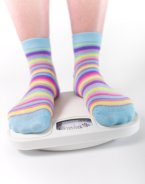How To Set A Weight Loss Goal

If you want to get somewhere, you have to know where you’re going, right? It’s no different when you want to lose weight. You need to set a weight loss goal to make sure you’re heading in the right direction.
If you’ve never set a weight loss goal or if you have a lot of weight to lose, it’s easiest to set a 3 month—or 12 week—goal. That gives you 12 weeks to turn your life around, by eating better and moving more.
To keep it simple, here are 2 types of goals you can set and the easiest ways you can track them.
Weight
Setting a goal weight is the easiest of goals. You only need to step on a scale and look down to track it.
You’ll need to aim for a weight loss of 1 to 2lbs a week. You may lose more than that during the first few weeks, but expect that to taper off.
A loss of 1 to 2lbs a week is more realistic – and healthier. Anything more than 2lbs a week and you’re most likely losing muscle, too. You want to lose fat, not muscle.
So, in 12 weeks, a reasonable weight loss goal would be anywhere from 12 to 24lbs. Pick a number you feel comfortable with – and it’s okay to aim high. Sometimes that’s just the right amount of motivation you need. Can you picture yourself 12 to 24lbs lighter in 3 months? If you’re just over 200lbs that could bring you under 200lbs!
Body Fat Percentage
Setting a body fat percentage goal is a bit more time consuming because measuring it is not quite the same as stepping on a scale. But when you measure your body fat percentage you can get a better idea of how much fat you’re losing.
A reasonable body fat percentage goal is around .5 % a week. 1% is achievable but you’re going to have to be really disciplined to do it.
In 12 weeks, a drop in body fat of 6% is a doable goal.
Track Your Progress Once a Week
Once you set your weight loss goal, you need to track how well you’re doing. Weigh yourself or calculate your body fat percentage once a week.
If you see a drop in weight or body fat, then keep doing what you’re doing. If the numbers go up, then you need to make changes to either your nutrition or exercise. Be honest about how much you’re eating and how hard you’re working out, and see where you can make changes so you can reach your weight loss goal.
How to Weigh Yourself Properly
- Make sure you have a good digital scale
that counts in 0.2lbs (it’ll be easier to track changes)
- Weigh yourself at the same time and on the same day
- Weigh yourself under the same circumstances (clothes/no clothes, in the same spot)
- Weigh yourself in the morning, if possible (You usually weigh less in the morning.).
Choose your start date and weigh yourself on that date. Write it down on a sheet of paper (don’t rely on your memory). Weigh yourself one week later, and write the result down again on the same sheet of paper. You can get fancy and create a table that tracks the changes for each of the 12 weeks, how much weight you’ve lost and how much until you reach your goal.
You can also use FitWatch’s free weight tracker.
How to Measure Body Fat in the Privacy of Your Own Home
There are several ways to measure your body fat percentage outside of the home, with hydrostatic testing being the most accurate. Bu we don’t all have access to such tests – and sometimes we’d just rather measure ourselves without anyone else around.
The key to measuring your body fat is to stick with one method. Even if it’s less accurate, by sticking to one method you will be able to track any changes.
Body Fat Percentage Calculator
With a body fat percentage calculator, you measure certain parts of your body and plug them into the calculator. The calculator calculates the percentage for you, so you don’t need to mess around with any math! You can use FitWatch’s body fat percentage calculator here: Body Fat Percentage Calculator
Body Fat Calipers
By far, the easiest way I’ve found to measure your body fat with calipers is by using the AccuMeasure calipers. You only need to measure in one place. It’s reliable, fairly accurate and convenient. You can do it yourself, in the privacy of your own home.
Body Fat Scales
Scales that measure your body fat tend to be unreliable, especially if you’re retaining water. You could use one, but my vote is for either the calculator or the calipers.
So, set yourself up for success by setting a reasonable weight loss goal. Don’t aim too low, and be sure you aim high enough without being unrealistic. Motivate yourself by giving yourself a big reward if you reach your goal. Track your progress and make changes when you need to. In 3 month’s time, you’ll be that much lighter and that much more fit – and then you can set your next 3 month goal!
